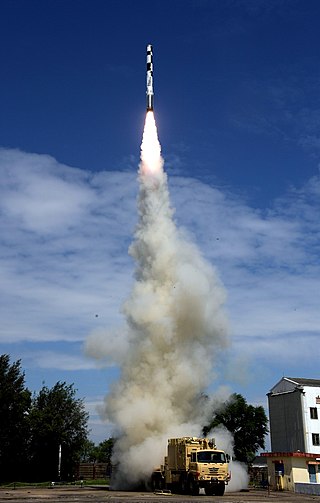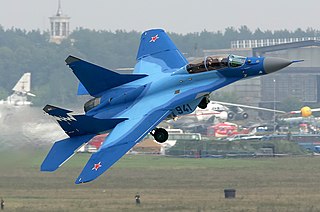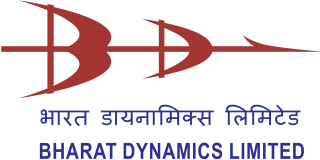The AIM-120 Advanced Medium-Range Air-to-Air Missile(AMRAAM) ( AM-ram) is an American beyond-visual-range air-to-air missile capable of all-weather day-and-night operations. It uses active transmit-receive radar guidance instead of semi-active receive-only radar guidance. When an AMRAAM missile is launched, NATO pilots use the brevity code "Fox Three".

An air-to-air missile (AAM) is a missile fired from an aircraft for the purpose of destroying another aircraft. AAMs are typically powered by one or more rocket motors, usually solid fueled but sometimes liquid fueled. Ramjet engines, as used on the Meteor, are emerging as propulsion that will enable future medium- to long-range missiles to maintain higher average speed across their engagement envelope.

The HAL Tejas is an Indian single-engine, 4.5 generation delta wing multirole combat aircraft designed by the Aeronautical Development Agency (ADA) and manufactured by Hindustan Aeronautics Limited (HAL) for the Indian Air Force (IAF) and Indian Navy. Tejas made its first flight in 2001 and entered into service with the IAF in 2015. In 2003, the aircraft was officially named "Tejas". Currently Tejas is the smallest and lightest in its class of supersonic combat aircraft.

The Vympel NPO R-77 missile is a Russian active radar homing beyond-visual-range air-to-air missile. It is also known by its export designation RVV-AE. It is the Russian counterpart to the American AIM-120 AMRAAM missile.

The Integrated Guided Missile Development Programme (IGMDP) was an Indian Ministry of Defence programme for the research and development of the comprehensive range of missiles. The programme was managed by the Defence Research and Development Organisation (DRDO) and Ordnance Factories Board in partnership with other Indian government political organisations. The project started in 1982–83 under the leadership of Abdul Kalam who oversaw its ending in 2008 after these strategic missiles were successfully developed.

The VympelR-73 is a short-range air-to-air missile developed by Vympel NPO that entered service in 1984.

Akash is a medium-range mobile surface-to-air missile (SAM) system developed by the Defence Research and Development Organisation (DRDO) and produced by Bharat Dynamics Limited (BDL). Surveillance and Fire control radar, tactical control and command center and missile launcher are developed by Bharat Electronics (BEL), Tata Power Strategic Engineering Division and Larsen & Toubro. The Akash missile system can target aircraft up to 45 km (28 mi) away. It has the capability to neutralise aerial targets like fighter jets, cruise missiles and air-to-surface missiles. It is in operational service with the Indian Army and the Indian Air Force.

Astra is an Indian family of all weather beyond-visual-range air-to-air missile, developed by the Defence Research and Development Organisation. Different missiles of this family are capable of engaging targets at varying distances of 500 m (0.31 mi) up to 340 km (210 mi). Astra Mk-1 has been integrated with Indian Air Force's Sukhoi Su-30MKI and will be integrated with Dassault Mirage 2000, HAL Tejas and Mikoyan MiG-29 in the future. Limited series production of Astra Mk-1 missiles began in 2017.

The BrahMos is a medium-range ramjet supersonic cruise missile that can be launched from submarines, ships, fighter aircraft or TEL. It is a joint venture between the Indian Defence Research and Development Organisation (DRDO) and the Russian Federation's NPO Mashinostroyeniya, who together have formed BrahMos Aerospace. The missile is based on P-800 Oniks. The name BrahMos is a portmanteau formed from the names of two rivers, the Brahmaputra of India and the Moskva of Russia.

The Mikoyan MiG-29K is a Russian all-weather carrier-based multirole fighter aircraft developed by the Mikoyan Design Bureau. The MiG-29K was developed in the late 1980s from the MiG-29M. Mikoyan describes it as a 4+ generation aircraft.

The Sukhoi Su-30MKI is a two-seater, twinjet multirole air superiority fighter developed by Russian aircraft manufacturer Sukhoi and built under licence by India's Hindustan Aeronautics Limited (HAL) for the Indian Air Force (IAF). A variant of the Sukhoi Su-30, it is a heavy, all-weather, long-range fighter.

The HAL Prachand is an Indian multi-role light attack helicopter designed and manufactured by Hindustan Aeronautics Limited (HAL) under Project LCH. It has been ordered by the Indian Air Force (IAF) and the Indian Army. Its flight ceiling is the highest among all attack helicopters.

The SPYDER is an Israeli short and medium range mobile air defence system developed by Rafael Advanced Defense Systems with assistance from Israel Aerospace Industries (IAI). Rafael is the prime contractor and IAI is the major subcontractor for the SPYDER program. This system achieved a notable milestone in 2005 when missiles were fired against test targets in Shdema, Israel and scored direct hits. Since then, it has been showcased in multiple military exhibitions throughout the world.

Bharat Dynamics Limited (BDL) is one of India's manufacturers of ammunitions and missile systems. It was founded in 1970 in Hyderabad, India. BDL, since its inception, has been working in collaboration with the Defence Research and Development Organisation (DRDO) and foreign original equipment manufacturers (OEMs) for manufacturing and supplying various missiles and allied equipment to the Indian Armed Forces. While fulfilling its basic role as a weapons system manufacturer, BDL has built up in-house R&D capabilities primarily focusing on design and engineering activities. BDL has three manufacturing units, located at Kanchanbagh, Hyderabad; Bhanur, Medak district, and Visakhapatnam, Andhra Pradesh.
The Indian Ballistic Missile Defence Programme is an initiative to develop and deploy a multi-layered ballistic missile defence system to protect India from ballistic missile attacks. It was launched in 2000 after Kargil War by the Atal Bihari Vajpayee government. Testing was carried out and continuing as of 2006, and the system was expected to be operational four years from then according to the head of the country's missiles development programme, Vijay Kumar Saraswat.
Iron Fist is an Indian Air Force exercise held at Pokhran, Rajasthan. It has been held twice: 2013 and 2016.

The Rudram is a series of air-to-surface ground attack and anti-radiation missiles in development by the Defence Research and Development Organisation of India. It can be launched from a range of altitudes with large standoff distance for destroying enemy surveillance radars, communication stations and bunkers.

Quick Reaction Surface-to-Air Missile (QRSAM) is a missile developed by the Defence Research and Development Organisation (DRDO), Bharat Electronics Limited and Bharat Dynamics Limited for the Indian Army, meant for protecting moving armoured columns from aerial attacks.

Akash - New generation abbreviated as Akash-NG is a mid-ranged mobile surface-to-air missile defense system developed by the Defence Research and Development Organisation (DRDO) and produced by Bharat Dynamics Limited (BDL) and Bharat Electronics (BEL).

The Vertical Launch – Short Range Surface to Air Missile, or VL-SRSAM is a quick reaction surface-to-air missile developed by the Indian Defence Research and Development Organisation (DRDO). During mid-course flight, the missile uses fibre-optic gyroscope based inertial guidance mechanism while in terminal phase uses active radar homing. With lock on before launch (LOBL) and lock on after launch (LOAL) capability, the missile receives mid-course update via datalink. VL-SRSAM intended to replace older Barak 1 surface to air missile system onboard Indian Navy warships. It will also be used as short range air defence system for Indian Air Force.

















